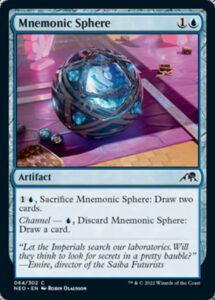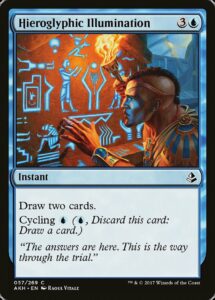Wizards of the Coast releases well over a thousand new cards each year. The eye is easily drawn to the most novel cards—splashy mythic rares, cards with brand new mechanics, and new designs that we can only guess at their functionality. But the majority of new designs are riffs on previous cards, where Magic mixes a dash of set’s core into established paradigms to produce something new yet still very familiar. This paradigm is absolutely a good thing, both for Magic (it makes filling out a set easier) and especially for its players. People are happy when they have a balance of familiarity and novelty—too much novelty and everything is overwhelming. But it is easy to overlook the familiar, given that much of its function is comfortably framing the new.
Today, we’re going to discuss a card that’s only a very slight deviation from its predecessor. Yet, as often is the case, there’s more than meets the eye to this fairly simple innovation.
Mnemonic Sphere is Courier’s Capsule with Cycling. It’s a little more complicated than that, as Channel doesn’t work with Astral Slide or Fluctuator, but in 99% of situations, that’s what it is.
It’s not as though Wizards was being measured in its experimentation here—we’ve seen plenty of different approaches in this vein and this template was what they needed in this situation. Font of Fortunes was another nearly identical design that was adapted for a very different format and enabled enchantment synergies instead. Ior Ruin Expedition was another discounted Divination with a hoop to jump through, as was Chart a Course. Behold the Multiverse is a very different package, but the core concept is the same: getting an Inspiration (with a bonus in its case) while distributing the cost over time. Medomai’s Prophecy does that too. And Witching Well. Heck, even Ichor Wellspring takes another bite at this apple, though it strays a bit farther from the tree.
Inspiration and Counsel of the Soratami are staple effects that have room for more power and ripe for remixing, just like Cancel, Shock, and Grizzly Bears. Wizards has played in the “distributed Divination” space a lot over the years, so it makes for them to pick a stable canvas on which to paint—especially in a set like Kamigawa: Neon Dynasty which needs a high density of artifacts, demands simple effects to offset potential complexity issues, and wants some easy rewards for Containment Construct.
The one part of the design on which I’m torn is the Channel ability. On the one hand, I love its simplicity and clear connection to Mnemonic Sphere‘s primary effect. It makes perfect sense for a card draw effect to output fewer cards when you spend less mana on it. You need these clear connections, because you can’t fill out a set exclusively with Channelers like Sunblade Samurai, Moonsnare Prototype, and Colossal Skyturtle. Cards with no mechanical or (clear) thematic connection to their Channel effect do good work, but work like that needs be done in moderation so people can remember what all the cards do.
On the other hand, the play pattern hasn’t struck me as satisfying. Hieroglyphic Illumination feels good to me because there is no cost distribution. Instant speed reduces the sting of spending four mana all at once, but you still have to spend four mana all at once. It feels good to Cycle on turns 1 and 2 (and even 3 sometimes) because you know it’ll be a long wait before you can cast it and then cast the cards it draws you.
While Mnemonic Sphere costs 4 mana to actually get the cards from, you pay in installments. You can start spending that mana as early as turn 2! It doesn’t even feel good Channeling it on turn 1, since you’re more likely to draw needed lands if you cast it on turn 2 and crack it the next turn. Why would you ever Channel it unless you’re in an enormous rush? There’s a tension to the design.
Giving it Channel makes it fit better into Neon Dynasty by showcasing a major mechanic in a clean manner, but that option is awkward because Cycling is a bit redundant on a card that already plays with cost. Sure, they could have just made Hieroglyphic Illumination with Channel, but this card slot really wants to be an artifact to support the artifact (and sacrifice) synergies. I respect that there are competing needs in game design and that Mnemonic Sphere gained relatively minor functionality to support the set; I just don’t love how it provides an option that I’ve found both a bit unappealing and of limited use.
Perhaps some of this stems from how Mnemonic Sphere isn’t as powerful as Omen of the Sea. The entire Omen cycle synergized beautifully with nearly every strategy in the set and was powerful for it, while Mnemonic Sphere works poorly with ninjas and isn’t even exactly what the artifact deck wants. It’s supporting architecture rather than a central pillar, and that can make it easier to focus on its flaws rather than the good work it does reflecting the spotlight to where it’s meant to be while subtly teaching you about the set.
Perhaps I’m using the card wrong because the cost reduction makes me too eager to be greedy. Perhaps this is purely personal bias and the design is just great. I can’t say which is correct, but I love this kind of conversation. I find so much joy in sifting through Magic’s simple-seeming designs to find all the hard work and all the precedent that led to them.
And, as always, thanks for reading.
Zachary Barash is a New York City-based game designer and the commissioner of Team Draft League. He designs for Kingdom Death: Monster, has a Game Design MFA from the NYU Game Center, and does freelance game design. When the stars align, he streams Magic (but the stars align way less often than he’d like).



